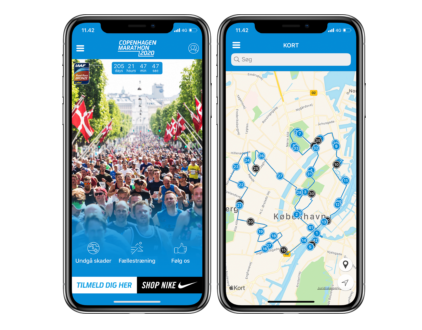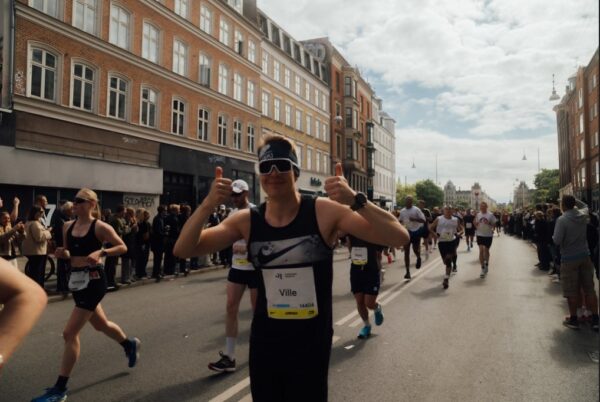If you’ve ever watched a big city marathon and felt that spark—like maybe, just maybe—you could be out there too, you’re not alone. I started as a curious, engaged spectator at the Copenhagen Marathon and ended up training for my first 42K. In this post, I’ll share how I went from watching on the sidelines to crossing the finish line, and why city marathons are one of the best ways to start your marathon journey. Whether you’re looking for beginner training tips, marathon motivation, or just curious what it’s really like to run with many thousands of others, this story is for you.

From Spectator to Runner – My City Marathon Story
I still remember the first time I stood at the finish line of a big city marathon. The Copenhagen Marathon, to be exact. It was a warm spring day in May, the streets were buzzing, and people lined the barriers cheering like their lives depended on it.
I wasn’t running that year—I was just a spectator. But something shifted in me that day. I wasn’t watching runners; I was watching ordinary people become heroes. That’s when the thought first crept into my mind: “Could I do this too?”
Back then, I had no marathon training plan. I didn’t even consider myself a “real” runner. But what I saw out there—the energy, the raw determination, the joy and pain mixed into one beautiful mess—it changed me. If you’ve ever thought about starting marathon running, let me tell you: showing up to a big city marathon is one of the best ways to fall in love with running.
The Magic of the Big City Marathon Atmosphere
There’s something surreal about the atmosphere at city marathons. It’s not just a race—it’s a celebration of human willpower. In cities like Berlin, Boston, New York, and my hometown in Copenhagen, marathon day feels like a public holiday.
You see families holding signs for loved ones, strangers clapping for runners they’ve never met, bands playing live music every few kilometers. It’s not just a run—it’s theatre. And when you’re in the crowd, you’re a part of that show, even if you’re not running.
When I visit the Copenhagen Marathon as a fan, I use my bike to get around quickly. It was a smart move from the beginning —cycling from one point to another let me catch my friends at multiple spots, cheer them on, and see the course unfold like a storybook. I even downloaded the official marathon app and used the live tracker to know exactly when they were approaching.

When Spectating Turns Into Dreaming
What I didn’t expect that day was how inspired I’d feel. Watching people of all ages and sizes give everything they had on the route made something click. I didn’t see elite athletes. I saw me—or at least someone I could become.
I’d overheard conversations about training plans, GPS watches, shoes, fueling strategies. At first, it all sounded like another language. But by the end of the day, I wasn’t just curious—I was committed. I went home, opened my laptop, and started researching beginner marathon training plans.
Within a few weeks, I’d printed my first 16-week schedule and taped it to the fridge.
My First Steps: From the Field to the Road

I wasn’t new to running—but marathon training was a different world. Years of soccer had given me speed, agility, and stamina in short bursts, but the long, steady rhythm of distance running? That was unfamiliar territory.
Still, I had a head start. I wasn’t gasping after 3 kilometers, but I quickly learned that endurance over 15 or 20 kilometers required a different mindset. It wasn’t about chasing a ball or reacting to a play—it was about pacing, patience, and staying mentally strong when no whistle marked the end.
I eased into training with three weekly runs and a weekend long run, layering in strength sessions and stretching—habits I’d already picked up from my time on the pitch. But this time, the challenge felt more personal. Long runs became my chance to disconnect from my usual day life, explore, and let my thoughts run free.
With each session, I wasn’t just building physical endurance—I was shifting my identity. I wasn’t just a former athlete staying fit. I was becoming a marathon runner.
When the Social Side Kicks In
One of the best things I did early on was join a local running group. I thought I’d feel like the slowest in the bunch, but I wasn’t. And even if I had been, it wouldn’t have mattered. Runners are a supportive tribe. We talked training, gear, favorite races. Some had run New York, others Berlin. One guy had done the Great Wall Marathon in China!
The stories were infectious. And the social encouragement—those weekly “nice job!” messages, the occasional group run, the shared sweaty selfies—kept me motivated more than any app ever could.
Race Day Reality: When the Plan Meets the Unexpected
I stuck to my training plan. I followed my fueling strategy. I drank at every official water depot along the route—just like I had during my long runs. But it was a very hot day, with relentless sunshine, and somewhere past the halfway mark, I could feel my body get out of balance. My mouth was dry, my legs heavier with each stride, and my focus began to decrease.
Dehydration had crept in, despite all my preparation.
It wasn’t extreme, but it was enough to change the race. I hadn’t anticipated how much the heat would take out of me. On paper, I had done everything right. But marathons don’t always follow the script. Conditions matter. So do the small things—like how your body reacts under pressure, on a hot day, surrounded by thousands of others pushing through the same challenge.
In that moment, the goal shifted. It wasn’t just about pace anymore—it was about perseverance. I slowed down, stayed aware, and reminded myself why I was out there. Training gave me the fitness. But it was sheer determination that carried me to the finish line.
The Magic of the Copenhagen Marathon

Copenhagen was where it all truly came together for me. I had watched it from the sidelines for years, but running it was something else entirely. The energy in the city that day was electric—cheering crowds lined the streets, from the old town to the wide boulevards, creating a wave of support that never seemed to fade.
What struck me most was how deeply personal the experience felt, even among thousands of runners. Every district brought a new atmosphere—families with signs, bands playing on corners, strangers offering high-fives and encouragement. Copenhagen knows how to celebrate its runners, and you feel it in your bones with every stride.
That day, I realized something bigger: marathons aren’t just about finishing 42.2 kilometers. They’re about people. Community. Stories unfolding on the pavement. And in Copenhagen, I was no longer just watching from the sidelines—I was part of the story.
The Gear That Grew With Me
When I started, I had no idea what gear I needed. I ran in old gym shoes and cotton shirts—not ideal. Over time, I learned:
– Good shoes (I now rotate between Asics and Saucony) are worth every penny.
– Moisture-wicking clothing keeps you dry and saves you from blisters and chafing.
– A GPS watch helps track your progress and gives you real confidence.
– Body Glide is magic. Trust me.
Each training cycle taught me something new—about gear, pacing, hydration, and above all, myself.
Where You Might Start (Even If You’re Not Ready Yet)
Maybe you’re reading this and thinking, “That sounds amazing—but I could never do it.” Let me stop you right there.
I thought the same. So did almost every runner I’ve spoken to.
But here’s the thing: you don’t have to run a marathon next week. You can start by walking. You can start by showing up as a spectator. You can download the marathon app, follow your friends, and feel the pulse of race day.
And maybe—just maybe—you’ll go home, pull out a calendar, and pick a race six months from now. Then you’ll find a simple plan that fits your life. You’ll run-walk your way through the first few weeks, huffing and puffing, maybe wondering what you signed up for.
But one day, when you’re deep in training, or standing on the starting line, or rounding the last turn with the crowd roaring—you’ll know exactly why you did it.
And I’ll be cheering for you.
Thanks for reading. If you found this helpful, feel free to share it with a fellow runner—or anyone who needs a reminder that the finish line is never as far as it seems.





